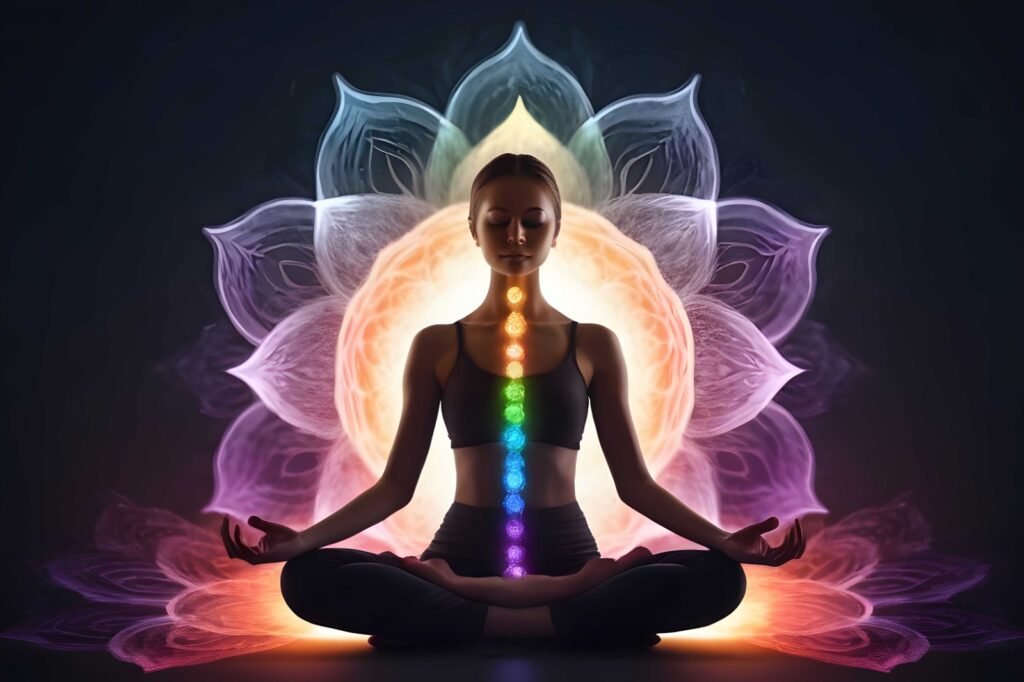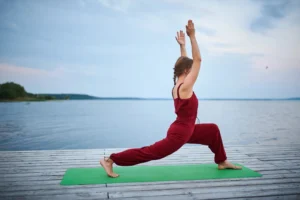What is kundalini Yoga ?
Kundalini Yoga is practiced all over the world, but its authenticity is yet to be discovered. The whole idea of Kundalini energy goes back many centuries to 1,000 B.C. Kundalini Yoga genuinely associates itself with Yogi Bhajan who hailed from Pakistan. He is supposed to have introduced the method to the western countries in the 1960s.
The word “kundalini” derives from the Sanskrit word “kundala,” which means “spherical.” It also means coiled serpent. Doctors say Kundalini energy is like a coiled snake; it sleeps at the base of your spine and doesn’t wake up.
Thus, Kundalini yoga is done in such a way that the energy flow is activated to spiral up your spine to the chakras. In yoga, the chakras are the seven energy centers in your body. These include:
- root chakra
- sacral chakra
- naval, or solar plexus, chakra
- heart chakra
- throat chakra
- third eye chakra
- crown chakra
With increasing Kundalini power, it is purported to balance chakras and thereby lead to your spiritual well-being. Regular practice leads to your spiritual enlightenment known as “Kundalini Awakening”.
Kundalini Yoga: A Practice Combining Meditation and Physical Postures
Kundalini Yoga is a combination of physical postures, breathing exercises, chanting, and meditation techniques designed to harness the mysterious potential force of Kundalini often said to be located at the base of the spine. It is an intense practice that can bring a lot of vitality, mental clarity, and proof of evolution on a spiritual level to one’s life.
Here is a rough guideline of how to proceed with Kundalini Yoga
1. The first step is to find a qualified teacher:
It is highly recommended that you start your practice of Kundalini Yoga under the guidance of a certified teacher who will be in a position to instruct properly, provide safety, and ensure that the practice is tailored to your needs.
2. Create a Sacred Space:
Find a quiet place where you can go undisturbed and uninterrupted. You may make a sacred atmosphere by using candles, incense sticks, or soft instrumental music.
3. Dress Comfortably:
Wear loose, comfortable clothes in which you can move around easily.
4. Start with a Chant or Mantra:
Most Kundalini Yoga practices start out with specific chants or mantras in order to invoke the energy or intention of what the practice is going to bring.
5. Do Some Physical Poses (Asanas):
Kundalini yoga asanas are very dynamic and repetitive. They stimulate the flow of energy in the body. Some of the asanas are as follows:
- Spine Twists: These help to detoxify your body and stimulate the spinal cord.
- Breath of Fire: Rapid, deep breathing beyond the satisfaction of the body’s needs.
- Cobra Pose: Promotes a powerful spine and expands the chest fully.
- Shoulder Rolls: An easy movement that eases the tension of your shoulder and neck muscles.
6. Include Some Meditation:
Meditation lies at the very core of the practice of Kundalini Yoga. One has to concentrate the psyche over one’s object/idea/mantra of focus.
7. Finish with a Relaxation Technique:
After the practice, take a few minutes to relax and integrate the experience. This could be deep breathing, perhaps a little guided imagery, or the ease of lying down and allowing the body to rest.
Core Principles of Kundalini Yoga
- Awakening of Kundalini: This latent energy is to be aroused from the Muladhara, its seat, and the passage through the spinal column upwards to the crown chakra is to be accomplished, emerging into spiritual enlightenment.
- Chakra Balance: Kundalini yoga is concerned with the balancing of the seven chakras or the seats of energy in the body for promoting complete well-being.
- Body-Mind Relationship: It involves the relationship and interaction of physical and mental states, respectively, and works toward the unison of both.
The power of the voice is a very important aspect. Mantras and chants pulsate into the body and mind to provide peace from within. So, it is the mantra that is the most commonly used key mantra in Kundalini Yoga. Sat Nam is the meaning of ‘Truth, my identity’
Meditation: The Path to Inner Peace
Meditation is an approach to achieving inner peace and heightened awareness by focusing the mind on a particular object, thought, or action. This leads to increased self-awareness and emotional control: directly training the mind to focus and direct it.
Role of Meditation in Spiritual Growth
- Self-Discovery: It is through meditation that a platform for introspection is provided that one can understand thoughts, feelings, and patterns.
- Reduction of Stress: It helps to control stress and anxiety by soothing the mind.
- Improved concentration: Continuous practice of meditation leads to concentration and clarity of mind.
- Balanced Emotions: It creates emotional stability and resilience in the mind.
- Spiritual Realization: Meditation can take a person’s spiritual journey in-depth, with an inner connection raising and connecting with a higher power.
Interaction of Kundalini Yoga and Meditation
- Prepare Physical asana and control of breath, through Kundalini yoga, brings into preparedness the body and mind for deep meditation.
- Activating energy: It has been said that some physical practices in Kundalini Yoga awaken and then channel energy and purify it using meditation.
- Deeper States: The combined meditation takes one into deep states and accelerates spiritual growth.
- Holistic Approach: Together, they cater to all parameters of improved or better health—physical, mental, or spiritual. When Kundalini Yoga and meditation are brought together to be integrated into a regular practice, a path is formed that becomes a journey of inner transformationality, resulting in personal discovery, inner peace, and spiritual growth.
Kundalini Yoga and Meditation: A Scientific Perspective
By the very nature of Kundalini Yoga, it forms an amalgamation of postures, physical exercises, breathing, and meditative techniques that is a combination quite unparalleled in its own right. A practice that has been noticed by several medical researchers, always with rising interest. Modern science is closely observing its core—an ancient spiritual tradition—for its potential effects on the neuropsychological system and brain function.
Impact on the Brain
- Expansion in brain volume: From different studies conducted, hippocampal volume enlargement has been established, which forms a crucial part in the memory and learning processes, and as such, the art form may well be considered neuroprotective.
- Enhances cognitive function: Many studies establish a link between Kundalini yoga practice and an increase in memory, attention, and problem-solving ability.
- Eases stress and anxiety: Brain imaging studies show that Kundalini yoga tends to reduce activity in those parts of the brain that are responsible for stress and anxiety, helping an individual stay calm.
- Increased Alpha Brain Waves: In making a mind relaxed and clear, alpha brain waves are increased by the practice of meditation in Kundalini Yoga.
Effect on the Nervous System
Improved autonomic function: Kundalini yoga improves autonomic nervous system functions that control functions like the heartbeat or gut.
Nervous System Balance: Kundalini yoga is said to bring balance between the sympathetic and parasympathetic nervous systems, leading to better stress management and general well-being.
Reduced Inflammation: It has been proved that the practice helps to reduce inflammation in the body, which might positively affect the nervous system.
Physiological and Psychological Effects
- Stress Reduction: This yoga is a very good stress-buster, as cortisol levels go down due to this yoga.
- Improved Mood: Due to increased positive neurotransmitters like serotonin and dopamine, its practice enhances moods towards happiness.
- Improved Immunity: The more one exercises, the more immunity is developed and the ability to resist diseases.
- Increased energy levels: Kundalini yoga helps in enhancing vitality and energy.
- Better Sleep: Kundalini Yoga has been reported to have improved quality of sleep by many people.
- Spiritual growth: This is purely a subjective experience, but people do feel a sense of heightened spirituality and closeness to one’s self.
How to Balance Kundalini Yoga and Meditation with Your Lifestyle
How to Balance Kundalini Yoga and Meditation with Your Lifestyle
- Self-care: Schedule self-practice like any other vital appointment and be sure to make time for your well-being.
- Realistic goals: Overtraining because of over-ambitious goals should be avoided. One should start at the level with which he can satisfactorily sustain his body, and then the intensity level could be increased gradually if required.
- Listen to your body: Take note of your physical and mental state. If it feels like too much, then it probably is Reduce the intensity or duration of training.
- Everyday life practice: Implement principles of meditation in the daily practice one does, to try something like mindful eating or mindful walking.
- Support system: Share your practice with friends, and try doing it in a group, like in a Kundalini yoga class to build a support system within the group.
Reliability and Overcoming Hurdles
- Notice the resistance: Realize any resistance and bring your awareness back to breathing.
- Experiment with different styles; if one meditation technique is hard for you, possibly try another. Maybe variety may spice up your practice.
- Be patient with yourself. Progress also takes time. Celebrate small victories and be kind to yourself in their setbacks.
- Use an alarm or notifications you can set to remind you for meditation, or give Kundalini yoga a shot.
- Practice with a friend: this is a great way to be more motivated and do the practice.
In all Kundalini Yoga and meditation, there is an integrated approach to well-being that takes into account the physical, mental, and spiritual realms. This practice can contribute to the total transformation of a person’s life: energize the body, enhance concentration, and inwardly bring peace. The benefits range from increased vitality and reduced stress to enhanced creativity and expanded growth.
We welcome you to further explore the adventurous world of Kundalini Yoga and Meditation. Whether you are a seasoned practitioner or just embarking on the path laid out before you, there is always something new to this adventure. Take small steps, find an experienced teacher, and allow yourself to commence this transformational journey.
The final essence of Kundalini Yoga and Meditation is self-connection to the self. It’s the road to self-discovery, empowerment, and enlightenment. By doing this practice, you invest in your life and your well-being above everything else. It starts you on a path of beginning to unlock the full potential of your real self.
Kundalini Meditation Techniques: A Beginner’s Guide
Key Features of Kundalini Meditation
Pranayama (Breathing Techniques):
- Long deep breathing – to be done by the practice of complete filling in of the lungs with an inhalation and complete emptying of the air with an exhalation. It calms the mind and allows the body to prepare.
- Breath of Fire: Fast inhale through the nose will tighten the abdominal muscles. This technique is mainly utilized for active energy.
- Asanas (Yoga Asanas): Kundalini Yoga has some special asanas, which are used to make the body’s nerve strong to activate the energy.
- Mantras and chanting: Mantra is a sacred sound or word utilized to focus the mind and intention of the energy. The mantra can be done either loudly or silently.
- Mudras – Hand gestures that aid in energy flow to bring more power to the meditation.
- Kriyas – These are exercises or sets of exercises for the purification of body as well as mind to get it under control.
- Meditation and visualization – Practice of deepening our meditative state by concentration on our breath, a mantra, or a particular image.
- Bandhas – Energy locks regulate the flow of energy to the body.
- Integration of Kundalini Yoga and Meditation into Daily Routine: Creating a Meditation Routine Find an ideal time: Try practicing meditation at different times to establish a practice when you are relaxed and aware. Morning time would be the best time to meditate and set the right pitch for the whole day. Alternatively, meditating at night can help in the release of stress.
- Make it short: Begin the practice with short meditation sessions of 5 minutes and increase the time gradually as you get comfortable. Quiet place: Locate a quiet and tranquil place where you feel you have your own private space; if there is a shortage of silence, soft background music or nature sounds may be used.
- Focus on your breath: Allow attention to rest on your breath as it moves in and out of your body. This simple anchor will help you keep your presence.
One can explore various forms of meditation like mindfulness, loving-kindness, or visualization to check on their suitability.
Consistency is the key; even with just a few minutes of practice, try to do so daily. Order is more important than length.
Conclusion
Remember: consistency. If you keep the dedicated practice even short in duration, big changes from the practice of Kundalini Yoga and Meditation are bound to enter..Hidden Mantra is a space that discusses the vision and Cultural aspects like Yoga, Buddhism, etc. Achieve trustworthy and reliable sources from Hidden Mantra blogs regarding the topics. Follow Hidden Mantra to achieve more informative content.










2 Responses
Kundalini Yoga is such a transformative practice! I appreciate how this post explains the connection between yoga and meditation in awakening inner energy. It’s inspiring to see how these techniques can help achieve balance and self-awareness. Thank you for sharing this valuable insight!
Thanks for your feedback!